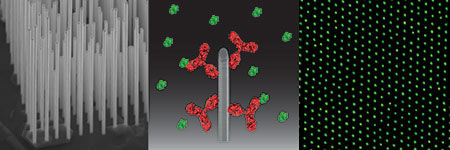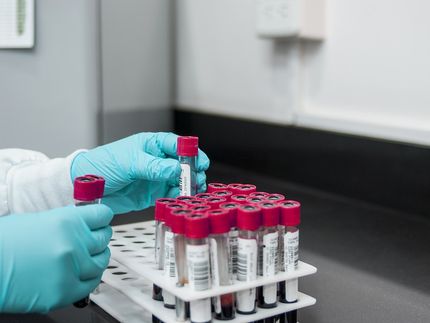Great potential for faster diagnoses with new method
The more accurately we can diagnose a disease, the greater the chance that the patient will survive. That is why many researchers are working to improve the quality of the diagnostic process. Researchers at the Nano-Science Center, University of Copenhagen have discovered a method that will make the process faster, cheaper and more accurate. This is possible, because they are combining advanced tools used in physics for research in biology at nanoscale, two scientific disciplines usually very distant from each other.

Left: Electron microscope image of nanowire forest. Middle: Diagram of a single nanowire with proteins (red molecules) which captures a different type proteins (green molecules) from a solution. Right: Typical fluorescence microscope image of proteins captures on nanowires (seen from above).
University of Copenhagen
Many diseases can be diagnosed using so-called biomarkers. There are substances, for example, that can be measured in a blood sample, which shows that the patient is suffering from the disease in question. These biomarkers are often proteins that are found in very small quantities in the blood, making it difficult to detect them. By measuring them, the diagnosing is more precise and many diseases can be detected very early, before the patient develops severe symptoms.
Great potential for faster diagnoses with new method
"We have developed a method in which we optimise the analysis of the proteins. A central point of this method is the use of nanowires to hold the proteins while we analyse them. It is unique.", explains Katrine R. Rostgaard, a PhD student at the Nano-Science Center, Department of Chemistry, University of Copenhagen.
Researchers normally use small plates to hold the proteins when they need to be analysed, but by using nanowires, which are cylindrical structures having a diameter of about 1/1000th of a human hair, they add a third dimension to the sample. The nanowires stand up like a little forest, creating a much greater surface area to hold the proteins because they can sit on all sides of the nanowire.
"With greater area, we can hold more proteins at once. This makes it possible to measure for multiple biomarkers simultaneously and it increases the signal, thereby providing a better quality of diagnosis.", says Katrine R. Rostgaard about the method, which has been published in the journal Nanoscale.
Profitable method for diagnosing
The research is done at the nanoscale on small size samples. The forests of nanowires are used to capture the proteins they want to study directly. When examining the proteins, you can reuse the nanowires by performing a multiple tests on the same protein. This simplifies the workflow in the laboratory tremendously in comparison to the conventional method, where researchers have to start over with a new plate to hold the proteins every time they perform a new analysis. In this way, the method helps to make the diagnostic process more environmentally friendly and economically viable for use in, for example, industry.
"We know that several major biotech companies will be interested in our new method and find potential applications, though it requires improvements before it is ready for use in the industry.", explains Karen Martinez, research group leader of the Nanobio group at the Nano-Science Center, Department of Chemistry, University of Copenhagen.
Most read news
Other news from the department science
These products might interest you

Kjel- / Dist Line by Büchi
Kjel- and Dist Line - steam distillation and Kjeldahl applications
Maximum accuracy and performance for your steam distillation and Kjeldahl applications

AZURA Purifier + LH 2.1 by KNAUER
Preparative Liquid Chromatography - New platform for more throughput
Save time and improve reproducibility during purification

Get the analytics and lab tech industry in your inbox
By submitting this form you agree that LUMITOS AG will send you the newsletter(s) selected above by email. Your data will not be passed on to third parties. Your data will be stored and processed in accordance with our data protection regulations. LUMITOS may contact you by email for the purpose of advertising or market and opinion surveys. You can revoke your consent at any time without giving reasons to LUMITOS AG, Ernst-Augustin-Str. 2, 12489 Berlin, Germany or by e-mail at revoke@lumitos.com with effect for the future. In addition, each email contains a link to unsubscribe from the corresponding newsletter.
























































